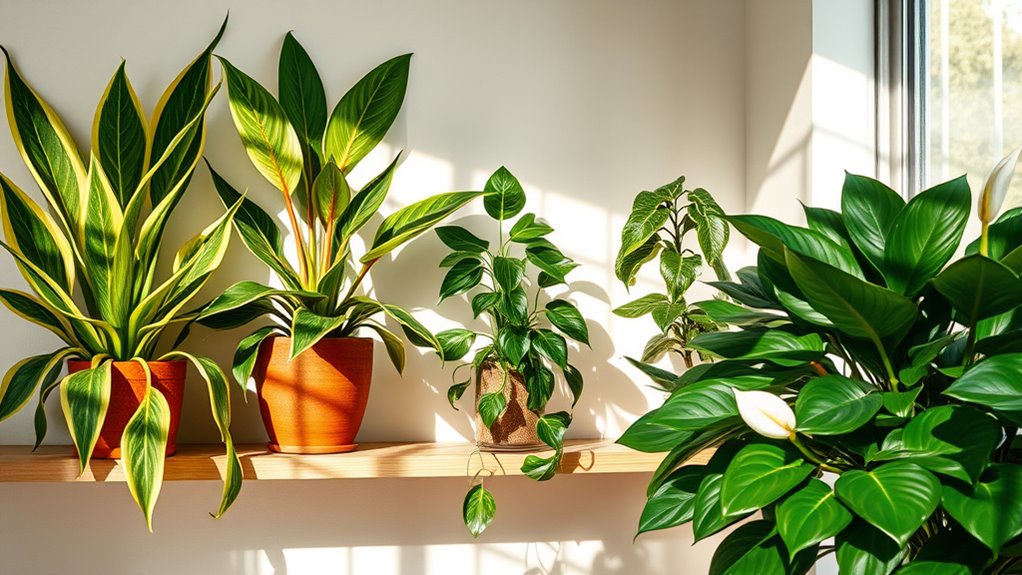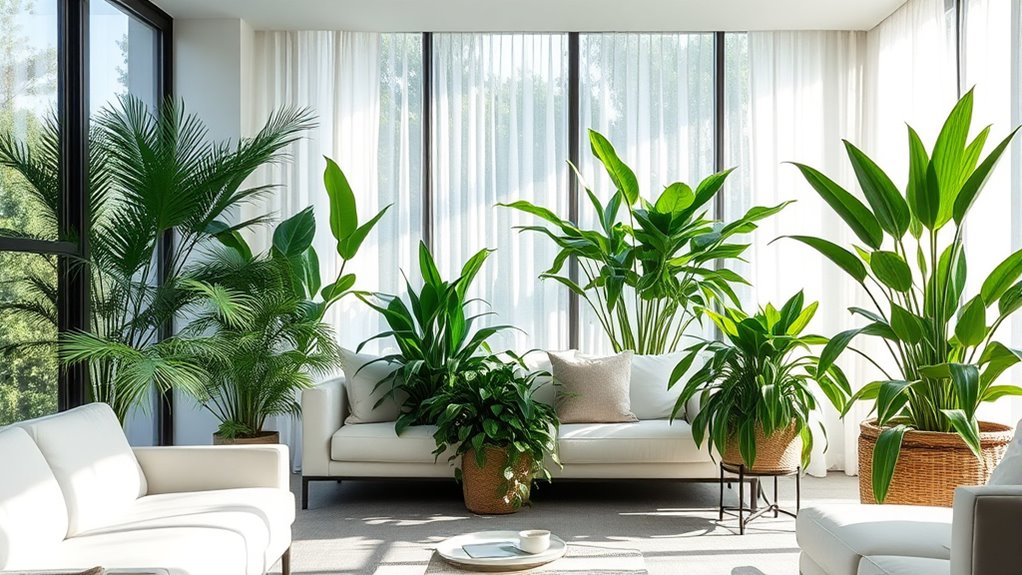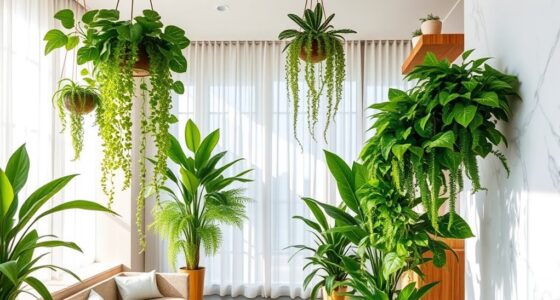If you’re looking for indoor plants that clean the air with minimal fuss, options like snake plants, pothos, peace lilies, and ZZ plants are perfect. These hardy plants thrive on low light, need only occasional watering, and require simple maintenance like dusting their leaves. They naturally filter toxins and improve your indoor air quality effortlessly. Want to discover how to choose and care for these easy-to-maintain air-purifying plants? Keep going to find out more.
Key Takeaways
- Choose low-maintenance plants like snake plants, pothos, peace lilies, and ZZ plants for effective air purification with minimal care.
- These plants thrive in low to moderate light and require infrequent watering, making them ideal for busy or forgetful owners.
- Regularly wipe leaves to maximize air filtering and keep plants healthy without complex maintenance routines.
- Place plants in suitable locations such as bedrooms or shaded areas for optimal air cleaning and oxygen release.
- Their resilient nature allows them to improve indoor air quality quietly, with minimal effort needed.

Have you ever wondered which indoor plants can actually improve the air you breathe? If so, you’re in luck. Some plants are not only beautiful but also remarkably easy to care for, making them perfect for anyone looking to enhance their indoor environment without much fuss. These low-maintenance greenery options are proven to filter out common indoor pollutants like formaldehyde, benzene, and trichloroethylene, helping you breathe cleaner air daily.
Discover easy-care indoor plants that naturally purify your air and brighten your space effortlessly.
One of the best choices is the snake plant, also known as Sansevieria. It thrives on neglect, needs minimal watering, and can survive in low light. Its upright, sword-shaped leaves add a modern touch to any room, and it actively filters out toxins while releasing oxygen at night—perfect for bedrooms. Another excellent option is the pothos, sometimes called devil’s ivy. It’s almost impossible to kill, tolerates low light, and requires only watering when the soil is dry. Its trailing vines are great for shelves or hanging baskets, and it works quietly in the background to purify your air.
The peace lily is also an outstanding plant for minimal fuss. It prefers shaded areas and only needs watering once a week. Its beautiful white flowers brighten any space, and it effectively removes airborne pollutants. Just keep in mind that peace lilies can be toxic to pets, so you might want to place them out of reach if you have animals. For a truly fuss-free option, consider the ZZ plant, which can survive in low light and only needs watering every few weeks. Its waxy leaves are drought-tolerant, and it quietly filters toxins, making it a practical addition to your home.
All these plants are resilient, require little maintenance, and do a remarkable job of cleaning indoor air. They thrive on simple care routines—watering only when needed, keeping them in low to moderate light, and occasionally wiping their leaves to keep dust off. You don’t need a green thumb to enjoy their benefits; they’re perfect for busy or forgetful plant lovers. By adding any of these plants to your home or office, you create a healthier indoor environment with minimal effort. They’ll work quietly in the background, improving air quality while requiring only occasional attention. With these easy-care plants, you get the benefits of cleaner air without the stress of complicated plant maintenance, making your space more comfortable and healthier to breathe.
Frequently Asked Questions
Which Indoor Plants Are Safest for Pets?
You should choose pet-safe indoor plants like spider plants, Boston ferns, and areca palms. These plants are non-toxic to cats and dogs, so you can enjoy greenery without risking your furry friends’ health. Keep in mind that even non-toxic plants can cause mild stomach upset if chewed excessively. Always double-check plant labels and consult your vet if you’re unsure about a specific plant’s safety.
How Often Should I Water Low-Maintenance Air-Purifying Plants?
A stitch in time saves nine, and watering your low-maintenance air-purifying plants every 1-2 weeks keeps them healthy. Check the top inch of soil; if it feels dry, it’s time to water. Avoid overwatering, which can cause root rot. During warmer months, you might need to water a bit more often. Remember, consistency is key to maintaining beautiful, healthy plants that clean your air effortlessly.
Can These Plants Survive in Low-Light Conditions?
Yes, many low-maintenance air-purifying plants can survive in low-light conditions. You can choose plants like snake plants, pothos, or ZZ plants, which thrive in less sunlight. These plants adapt well to indoor environments with minimal light, making them perfect for offices or shaded corners. Just guarantee you don’t overwater them, as they prefer drier soil and can tolerate dim environments without stress.
Do Air-Purifying Plants Require Special Soil?
Did you know that some air-purifying plants can remove up to 87% of indoor toxins? You don’t need special soil for these plants; regular potting soil works fine. Just guarantee it drains well and isn’t too dense. Using the right soil helps maintain healthy roots and supports the plant’s air-cleaning abilities. Keep your plants happy with proper watering and light, and they’ll keep your air fresh effortlessly.
Are There Any Plants That Remove Specific Toxins?
Yes, you can find plants that target specific toxins. For instance, the snake plant removes formaldehyde, benzene, and trichloroethylene, while the spider plant effectively filters carbon monoxide and xylene. These plants actively absorb pollutants through their leaves and roots, helping to improve your indoor air quality. To maximize their benefits, place them in areas where you spend the most time, and guarantee they get proper care with minimal fuss.
Conclusion
Bringing these plants into your home is like inviting quiet guardians to purify your space. They symbolize serenity and renewal, transforming your environment into a haven of fresh air and calm. As they quietly work, they remind you that sometimes, the simplest acts—like caring for a plant—can bring clarity and peace. Embrace these green allies, and let their subtle presence symbolize a fresh start and your commitment to a healthier, more harmonious life.









